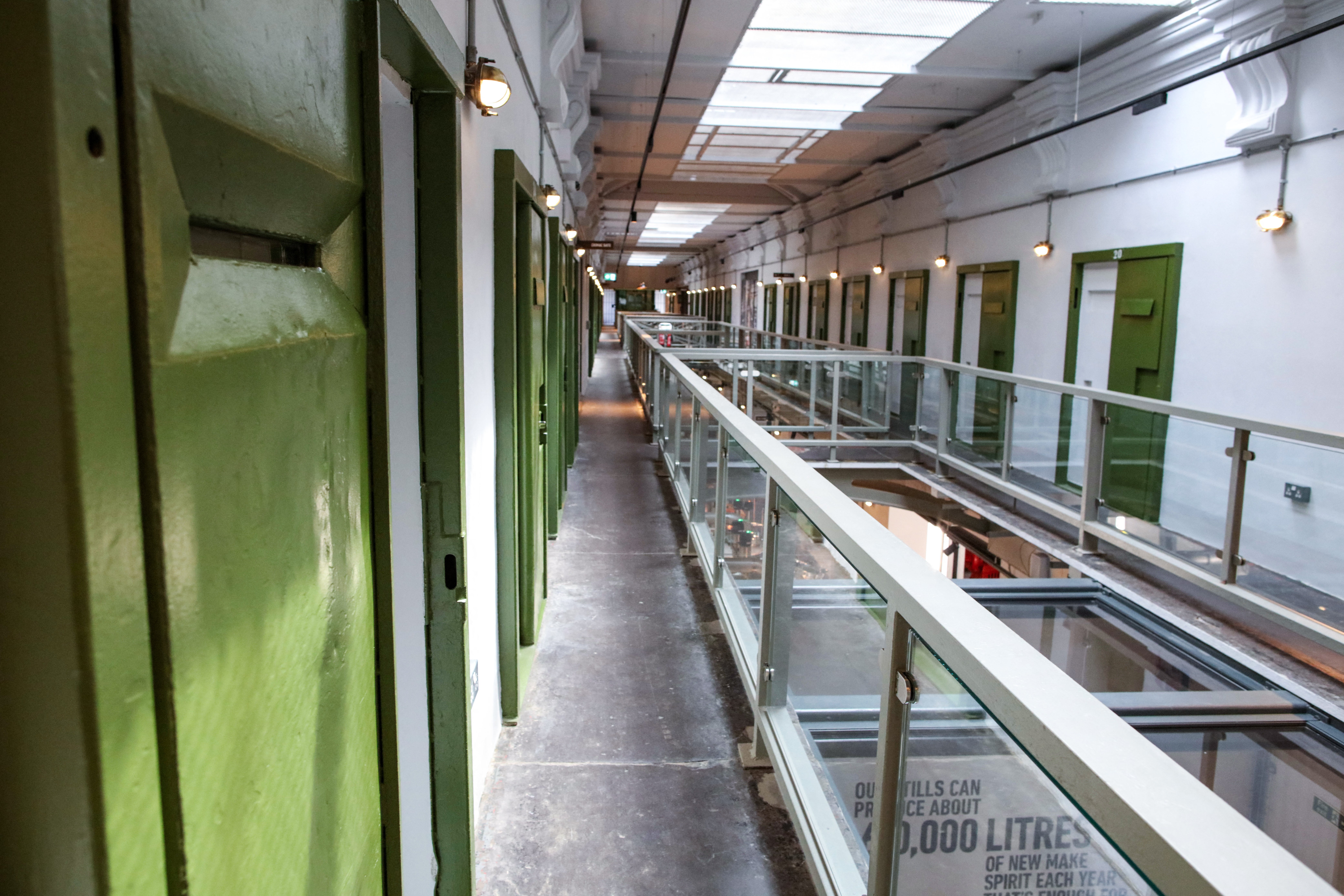Inside the virtual prison where a robot has you under house arrest
As more prisoners are released from a prison system bursting at the seams, Zoe Beaty looks at the new proposals to keep tabs (and nudge watches and alcohol blockers) on prisoners in their own homes under the watchful eye of AI


What does criminal punishment look like in 2024? Under new plans for low-level criminals, it could be a lot different to the boxy, bare prison cells we’re accustomed to in the UK. This week it was announced that, in order to address the prisons crisis, the justice secretary, Shabana Mahmood has launched a review of sentencing with the aim to reduce the demand for prison places, and “reshape and redesign what punishment outside of a prison looks like”.
The solution? House arrest – but make it modern.
The review comes at a crucial time in the thick of rapidly rising demand for prison places currently at a rate of about 4,500 prisoners each year and overcrowding has already pushed jails to “the point of collapse”, the government said in July.
Labour’s early release scheme, which allows criminals to serve just 40 per cent of their fixed-term sentences, rather than 50 per cent, saw around 1,700 prisoners released on 10 September; an additional 1,000 were expected to leave prison this week as the plans were extended to those serving sentences of five years or more.
It is, undoubtedly, a mess. Prison and probation are expensive and under-resourced to the point that it’s essentially incapable of doing the job it’s meant to – making the country safer. Some research shows that rehabilitation in prison might actually increase the likelihood of reoffending, and at a cost of £80,000 per prisoner, that is a big risk to take.
Now, alongside the overhaul of sentencing guidelines, led by the former Conservative justice secretary David Gauke, artificial intelligence and emerging technology will attempt to steer prison and probation services across England and Wales into a new era.
The “modern house arrest”, as termed by Mahmood, means something more rigorous – “ long hours of confinement, for example, more monitoring. And, crucially, making more use of smart technology. The question is, how would a “virtual prison” work? No one knows for sure. But – with a bit of imagination – it could look something like this...
Wakey wakey – His Majesty’s Prison Service is nudging you
House arrest still comes with obligations. So-called “nudge watches”, a type of smart technology that encourages users to behave in a certain way (like your Apple watch reprimanding you for sitting down for too long), are being tested on those on probation in the US. The compulsory watch nudges offenders when they’re due to attend an appointment with their probation officer, or “comply with other restrictions”.
According to a senior prison source speaking to The Guardian, the technology “could help offenders with ‘chaotic’ lives”. “They’re not things that restrict your liberty, but they are very helpful in terms of behaviour compliance and nudge compliance,” the source said.
The watches could be useful, agrees Mike Nellis, professor of criminal and community justice at the University of Strathclyde. Nellis was previously a social worker with young offenders in London and was long involved in the training of probation officers at the University of Birmingham. “These smartwatches that nudge people in terms of telling them they’ve got a court date or an appointment with a drug counsellor, that seems to me to be quite a creative use of technology,” he says. But it’s not the innovation that the probation service needs.

The service has been at breaking point for years, he explains, notably since the Conservative government under Chris Grayling tried to privatise it – “which damaged it in a way that it’s never recovered from”, according to Nellis. Staff turnover is incredibly high, with trainees fast-tracked through. “Very young and inexperienced staff are given highly dangerous, very serious offenders to supervise, and that’s no way to run a probation service if you want to minimise risk to people in the community.”
It means that staff, who are unsupported and overworked, are at risk, as are the criminals losing out on rehabilitation – and, ultimately, the public are at risk. While nudge watches are useful, there are much more pressing issues to deal with, says Nellis. “Any idea that this is a significant contribution to solving the prison crisis is ridiculous. We can talk about how wonderful technology is, and how useful it is, but we’ve got to produce something that’s equal to the challenges the service is facing. And I’m afraid that giving people smartwatches isn’t it.”
Make a cuppa (and mind the monitor)
Home monitoring units communicate with a monitoring centre using a radio frequency signal. Mahmood’s announcement included that offenders will have “sensors in the home” so “we can track their movements”.
“I think that’s a really effective sort of method that we have available to us. A prison environment, but outside of prison, is essentially what you’re seeking to recreate.”
The monitors will detect the presence of an ankle or wrist monitor within a certain range, and can send frequent updates to probation officers or monitoring stations. AI software will be able to predict suspicious behaviour – “like a convicted burglar driving around a neighbourhood at the same time every day”. In some countries automated calling, wherein “random calls are made to the residence, and the offender’s voice is recorded and compared to the offender’s voice pattern” is used.

The knock-on effect will likely be felt by electronic tag company Serco, which has a contract with the Ministry of Justice. The reason many offenders were released without tags in September is because “1,000 extra prisoners being released early ... was not anything they were properly prepared for”, says Nellis.
Get to (virtual) work
The idea of assigning criminals VR headsets for them to take virtual courses has been suggested. It’s not brand new – male prisons have already used VR to introduce offenders to work in construction or mechanics, for example. Under house arrest, they’d be trying their hand at similar courses to equip them with tangible skills that they can use to rebuild their lives. There’s just one (quite big) difference, though, says Nellis.
“The idea that we would sentence people to house arrest and tell them to spend four hours a day wearing a VR headset training as a plumber, that strikes me as ridiculous,” he says. “It’s displacing people with technology. If you want people to train as plumbers, you should send them to plumbing courses where they’ll meet people rather than just sitting in their own homes. It’s edging towards solitary confinement in the community.”
However, there are ways in which he believes AI could be useful – particularly when it comes to helping offenders understand their own decision making. In some uses, VR headsets show an individual with a history of burglary convictions, for example, a street where they can look at houses.
“If they see an open window, they can walk towards it. Something will flash up on the screen that says, ‘Could you have done something differently here?’ It’s to interrupt their thought process.” Nellis used similar techniques with flipcharts when working in probation services.
The obvious thing is that this type of technology is a lot more expensive than flipcharts. “VR tends to require very intensive data,” he says. “And the more data you generate, the more software you need to manage that data. And that is one that gets forgotten with the rubric of AI.”
Wind down for the day
But not with a drink. A transdermal device measuring the alcohol content of sweat produced by offenders on house arrests takes regular reports through an ankle or wrist bracelet. They’re uncomfortable to wear, says Nellis, “a fair number of people have problems with the tag chafing the skin”.

They were introduced in the UK three years ago and now researchers are working on developing a similar device to monitor drug intake – currently, it’s not possible since one device can’t detect multiple substances. “We can ban people for a maximum of 120 days,” says Nellis, “though it’s more often capped at 90 days. We tend to use it on those who get drunk and cause trouble at the weekend. And there's a lot of alcohol-related crimes, so it makes sense to do this.”
While the alcohol bans work – they do enforce abstinence – research shows that there’s a better way to implement the device. “In the Netherlands, they use exactly the same technology, but they also use it voluntarily. They talk to people to address their problem with alcohol and offer to help them by issuing a monitor.”
If our prison service is to improve, it’s an entire change of attitude – from punishment to prevention – that is needed, says Nellis. While the true details of what this new, more rigorous house arrest system would look like are still being worked out, it already appears to miss a crucial point.
“At the moment, the Ministry of Justice pays little more than lip service to the idea of rehabilitation, which, done properly, requires resources to help people with accommodation, employment, and to change their attitudes and behaviour. We’re in a position right now where we can’t even find accommodation for people when they’re released from prison – sometimes we’re giving them tents. We can’t even do the basics,” he says.
Breached the rules? AI will decide
There’s an argument that the outsourcing of a decision over whether an offender has broken their requirements might be more accurately dealt with by an algorithm. In fact, the Ministry of Justice first started using the offender assessment system (OASys) in 2001 – and since then, algorithms have had a huge influence in assessing and deciding the amount of “risk” individual criminals pose to society.
“But up to now, it’s nearly always a human being who judges whether that breaking of the rules – like straying outside an exclusion zone – has taken place,” explains Nellis. In the future, systems like that could change, and we’ve already seen that handing the reigns over to technology can lead to some frightening results.
In 2022, three US men spoke out after being misidentified by face recognition technology and unlawfully arrested. All three were Black, which, they said, was “not a coincidence”. Critics of AI use in criminal justice have long pointed out the perils of using algorithms subject to existing biases skewed against ethnic minorities.
“We’re going to have to face the challenges of AI sooner or later,” Nellis says. “It’s just as true in criminal justice as anything else.
“But the turn to technology rather than investing in people is not a meaningful solution to the prison crisis. In the longer term, we’ve got to somehow find a way of sending far fewer people to prison.”
For now, virtual prisons haven’t emerged into (virtual) reality. But, from the outside, it looks like a bit more than a fancy new headset might be needed to make the Ministry of Justice’s idea worthwhile.

